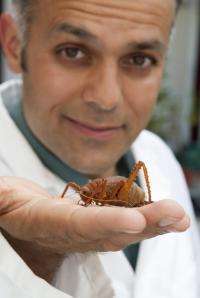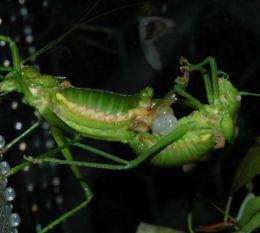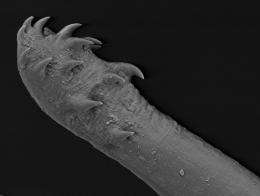Dr. Karim Vahed with cricket
(PhysOrg.com) -- The duration of sexual intercourse differs wildly across the animal kingdom. Now researchers seeking to understand the evolutionary significance of lengthy copulation duration have found evidence that it could signify a choosy male taking the time to assess the suitability of his female mate.
Dr. Karim Vahed from the University of Derby, and colleagues Dr. James Gilbert from the University of Cambridge; and Dr. Arne Lehmann from Stahnsdorf, and Professor Gerlind Lehmann from Humbolt University Berlin, Germany; carried out a study into the mating patterns of 54 different species of bush crickets (tettigoniids), recording and comparing a number of factors.
Male body mass, the duration of copulation (measured from the time the male establishes a firm grip on the female until the moment male ejaculate becomes visible) and the total quantity of male ejaculate (spermatophore mass) were established for each of the 54 species and compared for significant patterns. The results of the study have been published in the Journal of Evolutionary Biology (volume 24, pages 1960-1968).
Lead researcher Dr. Vahed, Programme Leader on the Masters degree (MSc) in Conservation Biology at the University of Derby, said: "Animals differ vastly in the nature of their sexual interactions and you see just as much variety between species of bush cricket. In the 54 species we investigated we discovered considerable variation between species in copulation duration from eight seconds to 104 minutes, for example. We wanted to discover the possible causes of this variation, and so compared copulation duration to other factors.
A mating pair
"We discovered that copulation duration was linked to the mass of the spermatophore the male transferred to the female cricket. Crickets with long copulation durations were more likely to transfer a large spermatophore."
A large spermatophore is costly for the male to produce and limits the potential number of times the male can mate. It could be suggested therefore that species which transfer a large spermatophore mass are particularly selective when it comes to finding a female mate.
A male bush cricket's titillator
"As we found this mass was linked to a long copulation duration, it could be reasoned that the duration of sexual activity prior to transfer may play a role in mate assessment. It's most likely that the male is assessing the female during this period as they are most in control of the duration of copulation, although we cannot rule out the possibility of female mate selection either."
The research team also investigated an intriguing aspect of bush crickets' sexual interaction - the presence and complexity of structures on male sexual organs know as titillators. Titillators are inserted into the female's genital chamber and move rhythmically with contractions of the male.
Karim said: "On comparing the presence or complexity of titillators to the other variables in our study we found that copulation duration was longer in species with titillators than without. This link between long copulation duration, large spermatophore mass and the presence of titillators suggests that titillators may either have a role in mate assessment or ensuring the female chooses to accept the male's ejaculate."
The study, led by Dr. Vahed, follows on from the team's discovery, published in Biology Letters in November 2010, that found the Tuberous Bushcricket (Platycleis affinis) has the largest testes (in relation to body weight) of any male in the animal kingdom, weighing in at 14% of the male body mass.
Provided by University of Derby






















